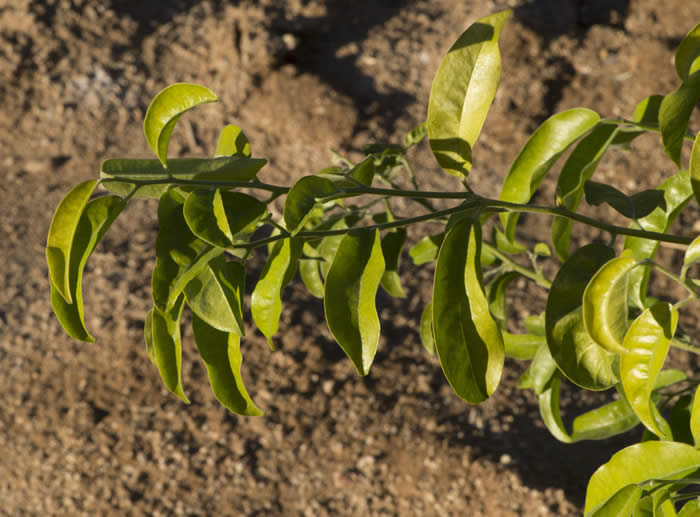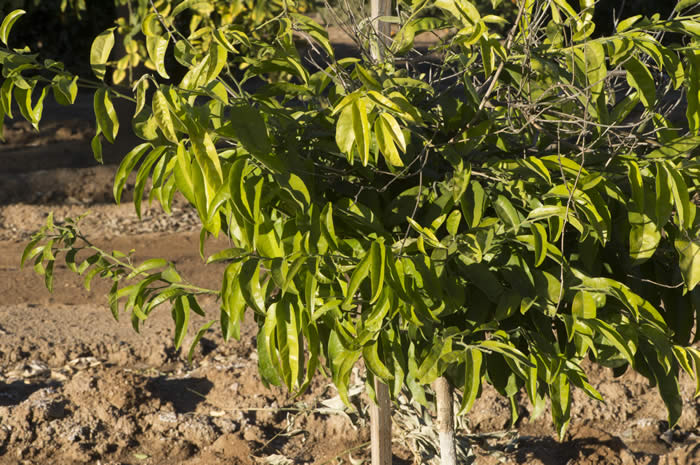Paramignya scandens
CRC 3509
PI 109758
Source
Received as seed from U.S. Plant Introd. Garden, Glen Dale, Md., 1956.
Parentage/origins
Parents unknown.
Rootstocks of accession
Own roots.
Season of ripeness at Riverside
Unknown
Season of flowering at Riverside
Unknown
Notes and observations
Received as "P. monophylla", is probably P. scandens. Description is given on old accession card, but this is probably description of P. monophylla. Too tender for the field here, keep in GH only.
Description from The Citrus Industry Vol. 1 (1967)
"Paramignya scandens (Griff.) Craib, Fl. Siam. Enum. 1:235. 1926. Citrus scandens Griff. Not. Ad. Pl. As. 4:495. 1854; Paramignya citrifolia Oliv. Jour. Linn. Soc. Bot. 5(2):42 (excl. synonymy! [non Limonia citrifolia Roxb.]). 1861; P. griffithii Hook. f. Fl. Brit. Ind. 1:510. 1875; Atalantia griffithii Guill. in Lecomte, Not. Syst. 1:183. 1910. Illus. Griffith, loc. cit. pl. 587, fig. 1.
Type.—Northern Burma, "Serpentine Mines," Mogung (?) Valley (Griffith, No. 519).
Distribution.—Northeastern India: Assam State; northern Burma; Thailand.
The original description by Griffith reads, translated, about as follows: "A spiny climbing shrub; spines smaller on twiglets or on inflorescences; twigs, petioles, and leaves pubescent; flowers white like the stamens, fragrant (with a suave odor), petals tinted green outside above the middle. Habitat: In wooded hills near the Serpentine Mines, toward Burma.
"A very distinct species, rare in upper Assam; common in the valley of the Mogoung, especially four leagues toward Serpentine Mines."
Griffith (l.c., vol. 4, pl. 587) shows a flowering twig, 24 cm long and 4.5-5 mm diam., with 10 leaves, and a portion of a large twig, 10-11 mm diam., with a single leaf and a flower borne on a lateral twig, 4-5 mm diam.; also a single fruit. No spines are shown on either twig.
The plate shows the following characters: Leaves lanceolate, with acute or slightly acuminate (one leaf is obtuse) apices, gradually narrowed, then abruptly rounded at the base; leaf blades 9-13 X 3.5-5.5 cm, glabrous above (?) but with scattered hairs below, veins 6-7 pairs, visible on both surfaces; petioles 9-15 mm long, 2.2-3 mm diam., pubescent; flowers arising singly or 2 (or 3?) in the axils of the leaves, 18-23 mm long, pedicels 6-8 mm long, 2 mm wide, with small bractlets near the base, pubescent like the petioles; calyx 4.5-6 mm wide, 4-4.5 mm long, with acute lobes 1.5-2.5 mm long; petals strap-shaped, narrowed toward the rounded tips, 18-20 X 3-4 mm, glabrous; staminal filaments 13-15 mm long, slender, glabrous, anthers short, 3 X 1.5 mm (less than 1/4 the length of the filaments), long oval; pistil 18-21 mm long; ovary subglobose, 4.5 mm diam., glabrous; style glabrous, 14-17 X 1-1.1 mm, stigma capitate, 3-3.8 mm diam.; fruits ovoid, 25-30 mm, bluntly pointed at apex, rounded at base, finely pubescent (?), borne on a subglobose (?) gynophore (4.5 mm diam. below) which remains attached to the apparently glabrous persistent calyx, no larger than when the flower opened. The plate gives every evidence of having been made carefully and accurately from a good flowering specimen.
Hooker (1875, vol. 1, p. 510) described P. griffithii (evidently named in honor of Griffith) and included Griffith's Citrus scandens,which he stated has very small flowers (only 6 to 8 mm long); yet Griffith's plate shows flowers 15 to 18 mm long. Hooker stated: "Griffith's figure is a great exaggeration, as his specimens show," but so great an exaggeration as this seems improbable, especially since the plate looks like a good cut made from the living plant. Possibly the best material was used to make the plate and the dried specimens that were put in the herbarium do not show the flowers properly and may even belong to another species.
Griffith described his plant as a species of Citrus, and because it was so utterly different from any known Citrus a detailed description probably seemed unnecessary. It would not be surprising if Griffith mixed up two species of Paramignya in his material of Citrus scandens.
It seems best for the present to let P. scandens stand as described and figured by Griffith and avoid attempting to include in it the widely different forms that have since been assigned to it. New material from the type locality, Mogoung Valley (?) in northern Burma, is needed to settle the status of this species."
Availability
Not commercially available in California.
USDA Germplasm Resources Information Network page for Paramignya scandens


